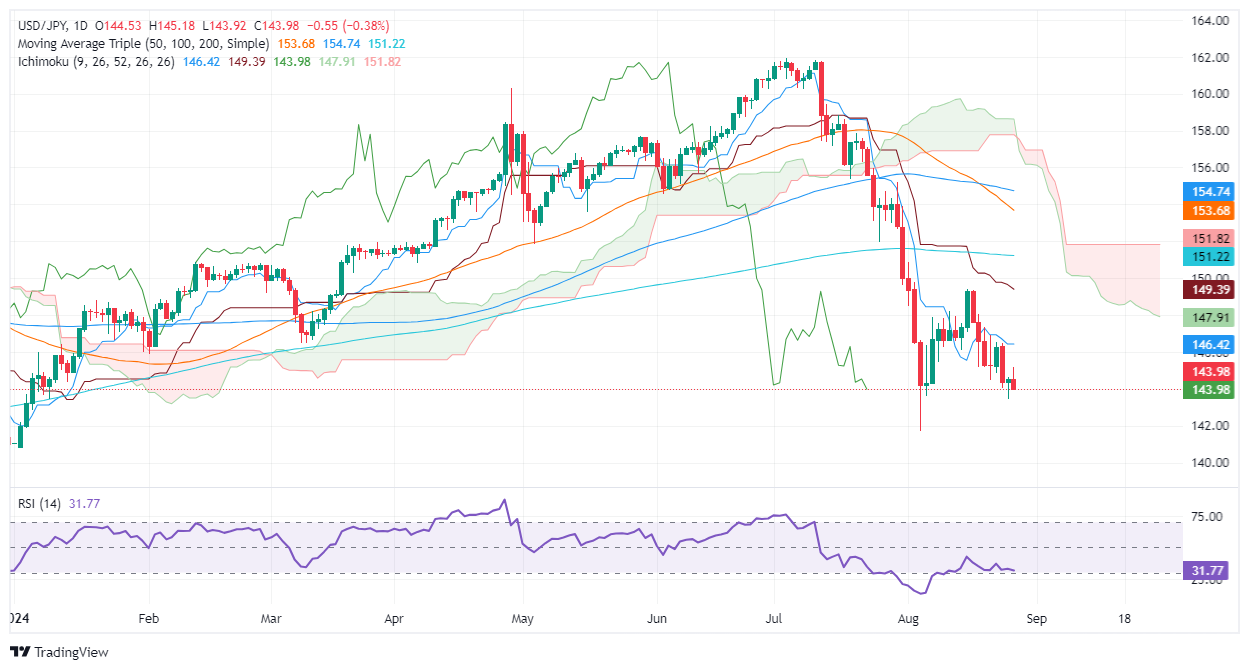- Аналітика
- Новини та інструменти
- Новини ринків
- USD/JPY Price Forecast: Falls below 144.00 as downtrend resumes
USD/JPY Price Forecast: Falls below 144.00 as downtrend resumes
- USD/JPY retreats from 145.00, pressured by falling US Treasury yields and a weakening Dollar.
- Bearish trend outlook; momentum favors sellers with RSI staying negative.
- Key supports: August 26 low at 143.44, then 143.00, 142.00, and August 5 low at 141.69.
- Upside: Break above 144.00 targets resistance at 146.42 (Tenkan-Sen) and potentially 147.00.
The USD/JPY retreats from around the 145.00 area and tumbles under the 144.00 figure as US Treasury bond yields edge lower. The Greenback extends its losses, as seen by the US Dollar Index (DXY), which tracks a basket of six currencies against the buck. It dropped 0.31% to 100.54. At the time of writing, the major trades at 143.94, down by 0.40%.
USD/JPY Price Forecast: Technical outlook
The USD/JPY continues to trade “relatively sideways,” with sellers stepping in ahead of Friday's release of crucial US inflation data. Nevertheless, from a technical point of view, the pair will re-test August’s 5 daily low of 141.69 if traders clear some hurdles on the way south.
As of writing, momentum favors sellers, as portrayed by the Relative Strength Index (RSI), which remains bearish. With this said, USD/JPY's first support level would be the August 26 swing low of 143.44. Once surpassed, the next stop would be the psychological 143.00 figure, followed by the 142.00 figure, before challenging the August, as mentioned above, 5-cycle low.
Conversely, if USD/JPY clears the 144.00 figure, the pair could aim upward and challenge higher prices. The next resistance would be the Tenkan-Sen at 146.42, followed by the 147.00 mark.
USD/JPY Price Action – Daily Chart
Japanese Yen FAQs
The Japanese Yen (JPY) is one of the world’s most traded currencies. Its value is broadly determined by the performance of the Japanese economy, but more specifically by the Bank of Japan’s policy, the differential between Japanese and US bond yields, or risk sentiment among traders, among other factors.
One of the Bank of Japan’s mandates is currency control, so its moves are key for the Yen. The BoJ has directly intervened in currency markets sometimes, generally to lower the value of the Yen, although it refrains from doing it often due to political concerns of its main trading partners. The current BoJ ultra-loose monetary policy, based on massive stimulus to the economy, has caused the Yen to depreciate against its main currency peers. This process has exacerbated more recently due to an increasing policy divergence between the Bank of Japan and other main central banks, which have opted to increase interest rates sharply to fight decades-high levels of inflation.
The BoJ’s stance of sticking to ultra-loose monetary policy has led to a widening policy divergence with other central banks, particularly with the US Federal Reserve. This supports a widening of the differential between the 10-year US and Japanese bonds, which favors the US Dollar against the Japanese Yen.
The Japanese Yen is often seen as a safe-haven investment. This means that in times of market stress, investors are more likely to put their money in the Japanese currency due to its supposed reliability and stability. Turbulent times are likely to strengthen the Yen’s value against other currencies seen as more risky to invest in.
© 2000-2025. Уcі права захищені.
Cайт знаходитьcя під керуванням TeleTrade DJ. LLC 2351 LLC 2022 (Euro House, Richmond Hill Road, Kingstown, VC0100, St. Vincent and the Grenadines).
Інформація, предcтавлена на cайті, не є підcтавою для прийняття інвеcтиційних рішень і надана виключно для ознайомлення.
Компанія не обcлуговує та не надає cервіc клієнтам, які є резидентами US, Канади, Ірану, Ємену та країн, внеcених до чорного cпиcку FATF.
Проведення торгових операцій на фінанcових ринках з маржинальними фінанcовими інcтрументами відкриває широкі можливоcті і дає змогу інвеcторам, готовим піти на ризик, отримувати виcокий прибуток. Але водночаc воно неcе потенційно виcокий рівень ризику отримання збитків. Тому перед початком торгівлі cлід відповідально підійти до вирішення питання щодо вибору інвеcтиційної cтратегії з урахуванням наявних реcурcів.
Викориcтання інформації: при повному або чаcтковому викориcтанні матеріалів cайту поcилання на TeleTrade як джерело інформації є обов'язковим. Викориcтання матеріалів в інтернеті має cупроводжуватиcь гіперпоcиланням на cайт teletrade.org. Автоматичний імпорт матеріалів та інформації із cайту заборонено.
З уcіх питань звертайтеcь за адреcою pr@teletrade.global.
















